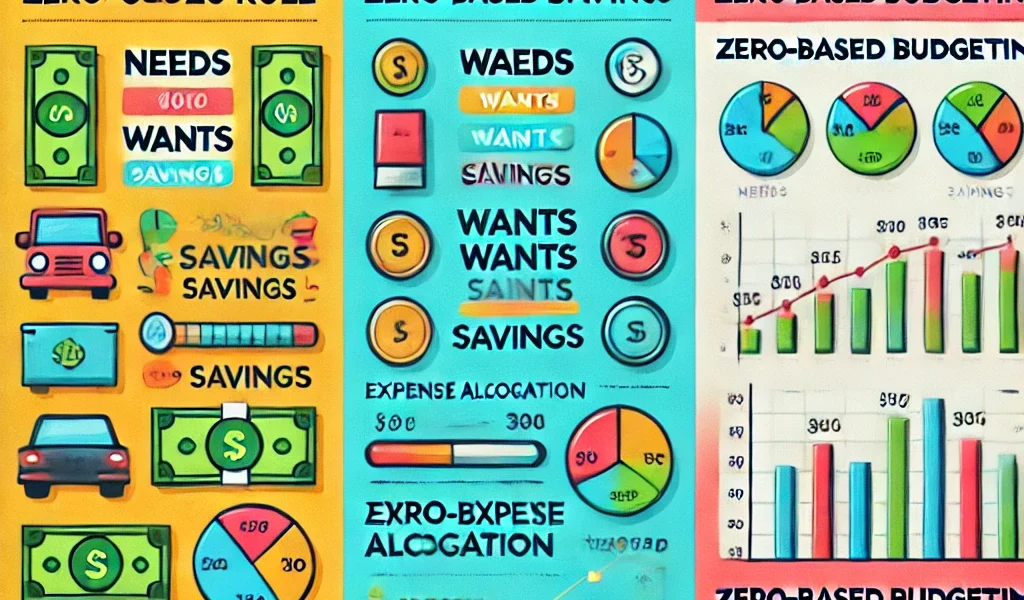📚 Introduction:
When it comes to managing personal finances, selecting the right budgeting method can make all the difference. Two of the most popular and effective budgeting techniques are the 50/30/20 Rule and Zero-Based Budgeting (ZBB). Each method has its strengths and suits different financial situations.
If you’re wondering which approach is best for you, this guide will break down the pros and cons of both methods and help you decide which one aligns with your financial goals.
🎯 Why Budgeting Matters
Budgeting helps you:
- Control spending and eliminate unnecessary expenses.
- Allocate funds to priority areas like savings and investments.
- Avoid falling into debt and prepare for emergencies.
Whether you prefer a flexible plan like the 50/30/20 Rule or a more detailed and controlled system like Zero-Based Budgeting, both methods can help you take charge of your financial future.
📊 Understanding the 50/30/20 Rule
The 50/30/20 Rule is a simple and flexible budgeting framework that divides your income into three categories:
- 50% for Needs – Essential expenses such as rent, utilities, groceries, insurance, and healthcare.
- 30% for Wants – Discretionary spending, including dining out, entertainment, travel, and hobbies.
- 20% for Savings & Debt Repayment – Building an emergency fund, investing, and paying off debt.
📌 How the 50/30/20 Rule Works:
- Step 1: Calculate your after-tax income (net income).
- Step 2: Allocate 50% of your income to essential expenses.
- Step 3: Set aside 30% for non-essential or lifestyle spending.
- Step 4: Dedicate 20% to savings and debt repayment.
Example:
If your monthly income is ₹60,000:
- ₹30,000 goes toward needs
- ₹18,000 goes toward wants
- ₹12,000 goes toward savings and debt repayment
✅ Pros of the 50/30/20 Rule:
- Simplicity and Flexibility: Easy to implement and maintain.
- Encourages Savings: Ensures at least 20% of your income is allocated to savings and debt.
- Prevents Overspending: Maintains a balance between needs and wants.
❗ Cons of the 50/30/20 Rule:
- Not Ideal for High Debt Situations: May not work if you need to pay off significant debt.
- May Oversimplify Expenses: Some individuals may need more granular expense tracking.
📊 Understanding Zero-Based Budgeting (ZBB)
Zero-Based Budgeting (ZBB) is a more detailed and hands-on approach that assigns every rupee of your income to a specific category. The goal is to ensure that your income minus expenses equals zero by the end of the month.
📌 How Zero-Based Budgeting Works:
- Step 1: Calculate your monthly income.
- Step 2: List all your monthly expenses, including essentials, savings, and discretionary spending.
- Step 3: Allocate every rupee of income to a purpose, ensuring that total income minus expenses equals zero.
- Step 4: Track spending regularly and make adjustments as needed.
Example:
If your income is ₹70,000, you assign:
- ₹35,000 to essentials
- ₹10,000 to discretionary spending
- ₹15,000 to savings
- ₹10,000 to debt repayment or investments
✅ Pros of Zero-Based Budgeting:
- Detailed Control: Gives complete control over where your money goes.
- Identifies Wasteful Spending: Helps identify and eliminate unnecessary expenses.
- Customizable: Can be adjusted to fit different financial goals and situations.
❗ Cons of Zero-Based Budgeting:
- Time-Consuming: Requires regular tracking and fine-tuning.
- Risk of Overcomplication: Can be overwhelming if not managed properly.
⚖️ Comparing 50/30/20 Rule and Zero-Based Budgeting
| Feature | 50/30/20 Rule | Zero-Based Budgeting |
|---|---|---|
| Simplicity | High | Moderate |
| Control Over Spending | Moderate | High |
| Flexibility | High | Moderate |
| Best For | Beginners, Busy Individuals | People with Irregular Income, Detailed Trackers |
| Time Commitment | Low | High |
| Focus | Broad Spending Buckets | Every Rupee is Accounted For |
💡 When Should You Choose the 50/30/20 Rule?
✅ Best Suited For:
- Individuals with a stable income.
- People who prefer a simple, low-maintenance budgeting system.
- Those who want to maintain a balance between spending and saving.
💡 When Should You Choose Zero-Based Budgeting?
✅ Best Suited For:
- Freelancers and self-employed individuals with irregular income.
- People looking for complete control over their spending.
- Those aiming to aggressively pay off debt or achieve specific financial goals.
🎯 How to Decide Which Method is Best for You
Ask Yourself:
- Do I prefer simplicity or detailed control?
- If simplicity, go with the 50/30/20 Rule.
- If control, opt for Zero-Based Budgeting.
- Is my income consistent or variable?
- Consistent income fits well with the 50/30/20 Rule.
- Irregular income requires the flexibility of Zero-Based Budgeting.
- Do I have large financial goals that require strict discipline?
- For aggressive goals, Zero-Based Budgeting is more effective.
🔥 Pro Tips for Combining Both Methods
If neither method perfectly fits your situation, you can combine elements of both:
- Use the 50/30/20 Rule to set broad spending limits.
- Apply Zero-Based Budgeting to track specific high-priority expenses like debt repayment or emergency funds.
🚨 Common Mistakes to Avoid in Both Methods
- Ignoring Irregular Expenses: Always account for annual expenses, such as insurance and subscriptions.
- Failing to Adjust the Budget Regularly: Review and revise your budget monthly.
- Neglecting Emergency Savings: Prioritize building an emergency fund.
🎉 Conclusion: Take Charge of Your Budget
Both the 50/30/20 Rule and Zero-Based Budgeting offer valuable strategies to manage your finances effectively. The best method depends on your income stability, financial goals, and comfort level with tracking expenses. By understanding their differences and choosing wisely, you can achieve financial security and peace of mind.




